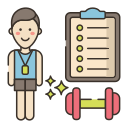Set Realistic, Measurable Goals
Choose a single outcome that genuinely matters, like jogging twenty minutes without stopping or completing eight push-ups with solid form. One focus keeps your plan tidy, progress visible, and motivation resilient when life inevitably gets busy.
Set Realistic, Measurable Goals
Transform “get fit” into a SMART goal: specific, measurable, achievable, relevant, and time-bound. For example, “three thirty-minute strength sessions weekly for eight weeks.” This structure reduces decision fatigue and highlights exactly what success looks like.



